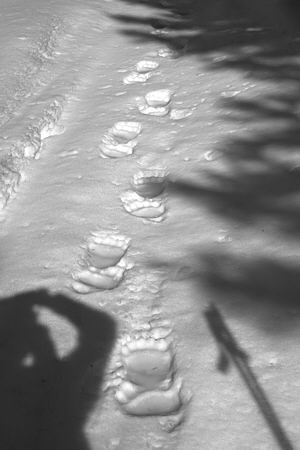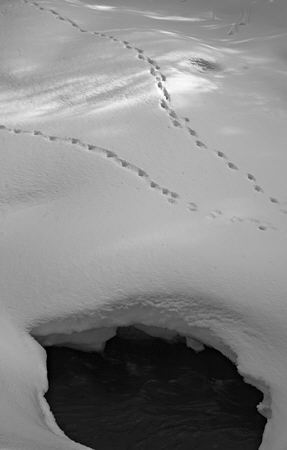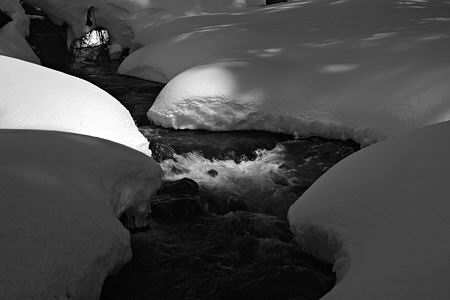I’ve often been asked whether there is any relation between my interest in art and my work in artificial intelligence (AI). At a practical level, where my work is aimed at making computers more “intelligent,” I’d say the connection is tenuous at best. But at a more philosophical level, AI is essentially cognitive science, which like art is intimately concerned with human perception. Questions about how visual perception works, from retinal stimulation to conceptual understanding and emotional response, are not only central to cognitive science, but probably its best-studied example. I think learning about the psychology of perception can be of value to artists, though certainly many care for it not at all, even if, through training or intuition, they are using its teachings anyway. I think a more explicit knowledge becomes especially useful in applied areas, such as how to design a pleasing and useful object of some sort, or how to alter a graphic or put words with it to achieve some desired effect.
An example of something that fascinates me from both art and AI perspectives was described in a recent New York Times article, When Language Can Hold the Answer. Several studies–more careful and convincing than previous ones–have shown a significant connection between language and visual perception. In this particular case, that translates into a different capability for color perception depending on the side of the visual field (left or right) of the stimulus, the reason being that some aspects of language are predominantly left-brain. One study found that Russian speakers, whose language makes a distinction between blues that English doesn’t have, are more sensitive to distinctions in blue in the right visual field only. Such a finding would probably not influence the way any “expressive” artist paints, but it might well lead to improving the effectiveness of an advertisement, which typically involves an image paired with certain “priming” words.

If it weren’t for artificial intelligence, I’d sometimes have no intelligence at all. Last Sunday I followed these bear tracks for miles, not exactly deliberately, but unwilling to give up my intended trail just because a bear was using it, too (and also hoping for a good sighting). I was evidently gaining on him or her, though not fast enough to catch up before the light began to fade and I turned back. On consulting several tracking books yesterday, I concluded that my quarry was most likely a grizzly out of its usual range, rather than the black bear I’d imagined. Not too smart, especially at this season.

Photographing tracks reminded me of Birgit’s duck dancing–letting animals make the marks–so I also photographed a set that I believe are bobcat, though the prints weren’t very clear in the shaded, looser snow. The black hole is the stream I had followed on the way up, and which had attracted most of my attention. Just as well.

In preparing the images above, I’ve been aware brightness and contrast and how the eye follows these cues. I experimented with slight color toning to influence the overall feeling, though in the end I preferred neutral shades of gray. These are things anyone with any background might do. In your case, does a theoretical understanding of perceptual psychology play any role in your working process? Or are you working entirely intuitively, or according to habits or methods you’ve acquired?

This is an interesting question — my immediate response is that there’s a problem with thinking of it as an either/or thing, when it’s more of a both/and or this-then-that-then-this-again thing. I have found — especially for the writing process which is so dependent on ruthless revision for its impression of casual spontaneity — that the more I understand the objective things, the better the writing becomes through their application.
But there are at least three components of the process: getting it on the page, letting it sit, and reworking it. Phase one is necessarily heedless, just the sometimes white-hot process of Taking Dictation from the Muse. But this can’t be mistaken for what writing “is” — the writing happens in phases 2 & 3, when the writer’s mind returns, looks at the writing as a lump of clay, sees the potential shape(s) for the thing, and then deliberately shapes it– leaving some things in, taking some things out, and making new stuff to fill the holes. (In my classes, I often cite the famous story about Michaelangelo getting a piece of marble and taking away everything that isn’t the angel. Michaelangelo had it easy, I say to my young writers, he didn’t have to first make the marble that he was going to have to cut away.)
In rewriting, there is some necessary oscillation between intuitve creating and mindful shaping so the work has unity, continuity, and wholeness. But that’s something that, for me, has developed, through time and practice, into a process so internalized as to seem unconscious. Like the practice of drawing a line over and over, so that it becomes “natural,” the way you do it, as though it were the way you had always done it. So there are always two minds at work — the receiving-intuitive mind, and the sifting-shaping mind — and each has prominence at different points in the process of forming something.
The idea of blocking that Dr Ramachandran identified is useful — that when you have some bits of an idea or image, they suggest additional bits, until you suddenly see and recognize the inevitable whole. The key is to have faith that the bits really are going to add up to something, and patience with the simple fact that some things take longer to ripen than others.
Now that I’m dabbling with picture-making, I’m finding that some of those practices are helpful (and comforting) in the new field. Leaving aside the great pleasure there is in just knowing stuff and in learning, I have found, in general, that the more I know about any one thing, the more I know about many things. I don’t know whether I believe that ‘knowledge is power’ but I do know that it sure is fun.
Well said, melanie! There are multiple parts to the creative process, which may or may not be separable activities in a given case. I’m convinced that a huge amount of the brain’s activity does not reach conscious awareness, so even what seem to be distinct phases are linked and inform each other underneath, so to speak.
I’m not confident that because many things don’t reach conscious awareness that they can’t be brought into conscious awareness. I wonder if much of what we think is ‘unconscious’ is — to sound more unkind than I intend it to be — a kind of laziness. Consciousness may be like learning to wiggle your ears — the muscles are there, you just have to be motivated to find them, figure out how to use them, and deploy your understanding effectively.
Steve:
I take it that grizzlies step in their own tracks.
I have been known to sleep with Art and Visual Perception by Rudolph Arnheim – not that much of it sinks in. I may apply it to my forehead – phylactery style – in hopes that an osmotic transfer occurs.
To Melanie’s three parts I would add maybe a three plus in the sense that, while proofing the dough, one folds in the critiquing process discussed earlier. An artist named Spinoza, who I believe is still working in the area, makes or made figurines resembling humanoid pupae, which he would bring to the museum for purposes of comparison. There was nothing in the collections quite like his work, but he found value in the juxtapositions he encountered. His was or is a prepared mind in the sense of gaining instruction from the accomplishments of others.
For me it’s pretty much practice altogether, Rudolph notwithstanding. Anyway, his book tends to report rather than surmise.
But then principles rather than theory may more aptly apply. I tend to agree that verity has no “privileged” place in art: if it looks good it is good being an operative principle. I also tend to think that aesthetics as phenomenon is no better understood or open to experiment than is action at a distance. We can talk about “fields” with high confidence while not really knowing what a field is. Artists can employ golden sections to their fields of canvas and paper, but the aesthetic impact of a golden section cannot be explained – drawing a connection between geometry and viewing satisfaction doesn’t settle the issue. Speculation goes wanting in the art I know.
Jay,
On a similar, if homier, note (to: “drawing a connection between geometry and viewing satisfaction doesn’t settle the issue”), I’ve been thinking about the fairly well known quote from William Morris: “Have nothing in your houses that you do not know to be useful or believe to be beautiful.” The idea that utility resides in knowing and(but?)beauty resides in belief intrigues me. I’m not sure either is wholly so.
Hungry grizzly bears, woken up from hibernation. Ice-cold streams. Watch out!
Otherwise, my brain is mush from jet-lag.
Melanie:
Mr. Morris must never have had a traffic citation arrive in the mail.
I don’t know about the utility/knowing and beauty/belief thing, even if something I said might have engendered it. Again, words can be slippery and making a case can be like pushing a wet noodle. Taking up these words; well crafted utilitarian objects can have an acknowledged beauty that can derive from shape, composition and appropriate design. Mathematical constructs are sometimes deemed beautiful and accepted as knowledge in the sense that they correlate to something in the real world, even before such a correlation is determined. As for belief and beauty – maybe it’s in the eye of the believer.
The Morris quote seems to embody the folk wisdom that usefulness might be somewhat generally agreed on, whereas beauty is a more individual judgment. Neither is wholly true, of course, as melanie suggests. I think the parallel for me to what she finds intriguing is that we can find a personal beauty in the utilitarian and familiar. Similarly, I don’t feel at all that I’m trying to capture “beauty” when I photograph, and yet I manage to find something I could call beauty in some of the results, even though I know there would be no common agreement on that.
Jay,
I think the bear was walking a bit faster here, so the large hind foot steps almost past the front foot. Elsewhere, they’re nearly in registry, a common walking gait. Size-wise, the hind foot is the same length as mine but much wider, and the stride is 4.5 feet.
melanie,
I think you’re right that we can learn to bring more to consciousness, and that is likely to improve the process (and result), not to mention make it more satisfying.
Steve,
I hope that you will do a sequence on tracks in the snow (before the Grizzlys’ get you). I love your earlier tracks in the snow http://www.artandperception.com/2008/02/art-walk.html
In my limited bayliwick, artificial intelligence meant neural network modeling. I have to think about its wider application to perception
Steve,
Since our local paper prints NY Times articles, generally about 3 days late, and I also get the Sunday times, I’ve read the article you refer to at least twice now. The conundrum that I found most interesting was that language indeed enables people to identify and work more efficiently — quicker and more accurately. So if you knew two different kinds of blue because your language had words for them, you could find the matching colors in sets that contained various blues kinds more readily. You would work more quickly and more accurately.
However, something of the obverse is also true — that once you’ve acquired the language – say bump and beet for green/blue and red/blue — you tend to lump all blues into one or the other category. You tend not to see other possibilties.
This latter problem has repercussions for students of the arts — we are taught to see efficiently — “tree” or even “oak tree” so we come to think of “oak tree” instead of “the tree that has the faintest blue color in itse early green leaves” (I made that up).
It’s what the drawing teachers tell you from the git-go — drawing is first and foremost learning to see –that is, to see with the inefficent, unlanguaged mind. In that sense, it’s very like Melanie’s Taking Dictation from the Muse. You have to take that dictation before you decide what the shape or color you’ve been given is called.
This seems intuitively obvious, but I loved it that they found a way to research the question. That they could go on and discover that when the language was interfered with, the Russians lost their advantage in dealing with color was striking.
By the way, I’m glad the grizzly didn’t get you — and that you got his footprints.
June,
Thank you for bringing up an absolutely crucial point! Categorization is a key aspect of almost all cognition. The act of assigning a color name to a color patch, a syllable to a sound, or, at a higher level, naming an object or hearing a word, are examples from perception. Much of our reasoning in other areas is equally based on similar generalization/labeling/categorization (think politics, for example). This strength has the obvious weakness you note; it allows us to bring past knowledge of something to bear, but it can also inhibit accurate observation of what is new or different. In the area of visual art, this has always been the meaning for me of the title of Wechsler’s biography of Robert Irwin, Seeing is Forgetting the Name of the Thing One Sees (I can’t remember if that’s a quote from Irwin or elsewhere–anyone know?)
On a technical note, in AI we distinguish two kinds of categorization, classification of things into pre-defined categories (e.g. given by language or definitions) and clustering of things into groups based on similarity (more problematic than it seems), which groups then constitute the “discovered” categories. My work, by the way, involves doing both kinds of categorization with text documents.
Steve,
thanks for the fascinating AI way of distinguishing categories — “classification” and “clustering.” The latter reminds me of maps and file keeping, both of which can be widely (and wildly) varied, depending upon the intent of the mapmaker or filekeeper.
For example, I have seen (visual) journal “maps” which record, in drawings, scenes in the “path” along which the artist walks each day. These bear little resemblance to the map of the terrain or the roads, but are equally valid in their way to the road atlas we all know.
Clustering also makes me think of those “clouds” that image groups of things that change: for example, “categories” in blogs that garner the greatest number of hits show n as “clouds” — the larger the typeface, the more popular the category, sizes which could change at any given moment.
In both these cases “clustering” seems like a more appropriate kind of category than “classification,” although one might derive a classification from such clusterings.
I suspect, given your comment “more problematic than it seems” that you are working on far more difficult to resolve clusters or seeming clusters of things. I’m thinking of those sets of overlapping ven diagrams that I used to love to suss out when I was an undergraduate. But what a wonderful distinction you have presented me with here — something to ponder while I paint.
June,
If the clouds are categories for a blog, they represent essentially pre-defined categories into which posts are placed (true, new ones can be created at need) hence assigning categories is “classification.” Some of those clouds are, however, displaying prominent words contained in posts, and hence represent emergent categories, “clusters” that are similar by virtue of containing the same words.
By “problematic” I meant that the idea of what counts as similar is not obvious, and depends on culture, purpose, etc. Given a wool cap, heavy mittens, gardening gloves, and a sun hat, you might organize into headgear and handgear categories, or winter and summer categories. Neither is necessarily wrong or right.
Steve,
Oh good, I did comprehend “Classification” and “Cluster.” I never had such a nice precise language differences available to me although obviously the concepts are familiar.
Your word “problematic” was exactly what I thought it meant — I am most familiar with filing systems that make perfect sense — to the person doing the filing. But to someone else, they can seem totally arbitrary, because of different cultures, purposes, etc. Jer is always stunned and dismayed at my computer “desktop” he organizes his materials completely differently.